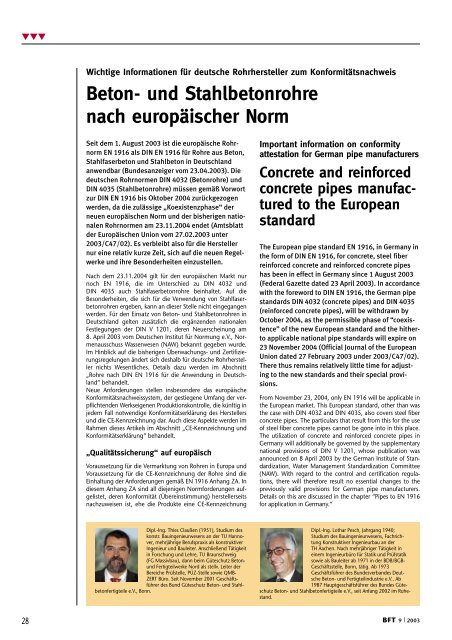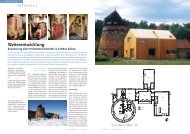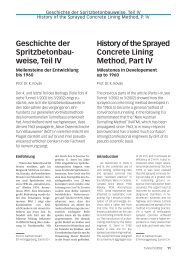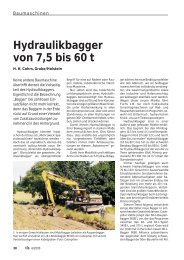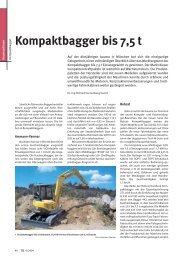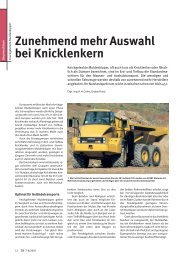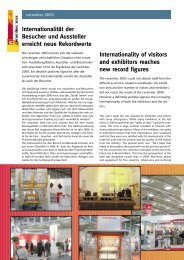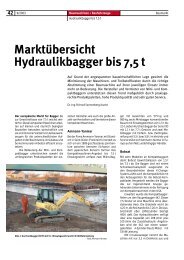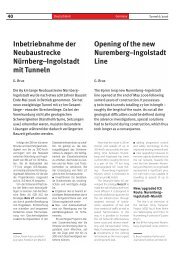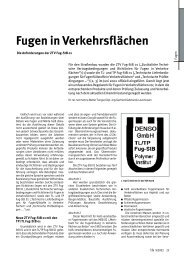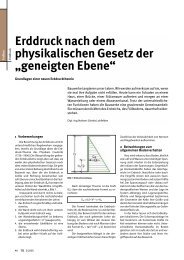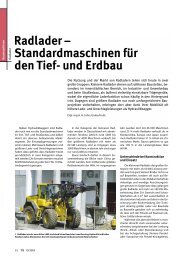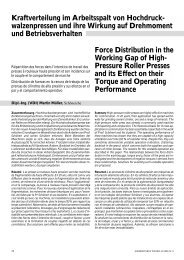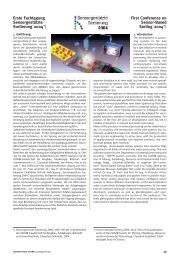Beton- und Stahlbetonrohre nach europäischer Norm - Bauverlag
Beton- und Stahlbetonrohre nach europäischer Norm - Bauverlag
Beton- und Stahlbetonrohre nach europäischer Norm - Bauverlag
Erfolgreiche ePaper selbst erstellen
Machen Sie aus Ihren PDF Publikationen ein blätterbares Flipbook mit unserer einzigartigen Google optimierten e-Paper Software.
▼▼▼<br />
28<br />
Wichtige Informationen für deutsche Rohrhersteller zum Konformitäts<strong>nach</strong>weis<br />
<strong>Beton</strong>- <strong>und</strong> <strong>Stahlbetonrohre</strong><br />
<strong>nach</strong> <strong>europäischer</strong> <strong>Norm</strong><br />
Seit dem 1. August 2003 ist die europäische Rohrnorm<br />
EN 1916 als DIN EN 1916 für Rohre aus <strong>Beton</strong>,<br />
Stahlfaserbeton <strong>und</strong> Stahlbeton in Deutschland<br />
anwendbar (B<strong>und</strong>esanzeiger vom 23.04.2003). Die<br />
deutschen Rohrnormen DIN 4032 (<strong>Beton</strong>rohre) <strong>und</strong><br />
DIN 4035 (<strong>Stahlbetonrohre</strong>) müssen gemäß Vorwort<br />
zur DIN EN 1916 bis Oktober 2004 zurückgezogen<br />
werden, da die zulässige „Koexistenzphase“ der<br />
neuen europäischen <strong>Norm</strong> <strong>und</strong> der bisherigen nationalen<br />
Rohrnormen am 23.11.2004 endet (Amtsblatt<br />
der Europäischen Union vom 27.02.2003 unter<br />
2003/C47/02). Es verbleibt also für die Hersteller<br />
nur eine relativ kurze Zeit, sich auf die neuen Regelwerke<br />
<strong>und</strong> ihre Besonderheiten einzustellen.<br />
Nach dem 23.11.2004 gilt für den europäischen Markt nur<br />
noch EN 1916, die im Unterschied zu DIN 4032 <strong>und</strong><br />
DIN 4035 auch Stahlfaserbetonrohre beinhaltet. Auf die<br />
Besonderheiten, die sich für die Verwendung von Stahlfaserbetonrohren<br />
ergeben, kann an dieser Stelle nicht eingegangen<br />
werden. Für den Einsatz von <strong>Beton</strong>- <strong>und</strong> <strong>Stahlbetonrohre</strong>n in<br />
Deutschland gelten zusätzlich die ergänzenden nationalen<br />
Festlegungen der DIN V 1201, deren Neuerscheinung am<br />
8. April 2003 vom Deutschen Institut für <strong>Norm</strong>ung e.V., <strong>Norm</strong>enausschuss<br />
Wasserwesen (NAW) bekannt gegeben wurde.<br />
Im Hinblick auf die bisherigen Überwachungs- <strong>und</strong> Zertifizierungsregelungen<br />
ändert sich deshalb für deutsche Rohrhersteller<br />
nichts Wesentliches. Details dazu werden im Abschnitt<br />
„Rohre <strong>nach</strong> DIN EN 1916 für die Anwendung in Deutschland“<br />
behandelt.<br />
Neue Anforderungen stellen insbesondere das europäische<br />
Konformitäts<strong>nach</strong>weissystem, der gestiegene Umfang der verpflichtenden<br />
Werkseigenen Produktionskontrolle, die künftig in<br />
jedem Fall notwendige Konformitätserklärung des Herstellers<br />
<strong>und</strong> die CE-Kennzeichnung dar. Auch diese Aspekte werden im<br />
Rahmen dieses Artikels im Abschnitt „CE-Kennzeichnung <strong>und</strong><br />
Konformitätserklärung“ behandelt.<br />
„Qualitätssicherung“ auf europäisch<br />
Voraussetzung für die Vermarktung von Rohren in Europa <strong>und</strong><br />
Voraussetzung für die CE-Kennzeichnung der Rohre sind die<br />
Einhaltung der Anforderungen gemäß EN 1916 Anhang ZA. In<br />
diesem Anhang ZA sind all diejenigen <strong>Norm</strong>forderungen aufgelistet,<br />
deren Konformität (Übereinstimmung) herstellerseits<br />
<strong>nach</strong>zuweisen ist, ehe die Produkte eine CE-Kennzeichnung<br />
Dipl.-Ing. Thies Claußen (1951), Studium des<br />
konstr. Bauingenieurwesens an der TU Hannover,<br />
mehrjährige Berufspraxis als konstruktiver<br />
Ingenieur <strong>und</strong> Bauleiter. Anschließend Tätigkeit<br />
in Forschung <strong>und</strong> Lehre, TU Braunschweig<br />
(FG Massivbau), dann beim Güteschutz <strong>Beton</strong><strong>und</strong><br />
Fertigteilwerke Nord als stellv. Leiter der<br />
Bereiche Prüfstelle, PÜZ-Stelle sowie QMB-<br />
ZERT Büro. Seit November 2001 Geschäftsführer<br />
des B<strong>und</strong> Güteschutz <strong>Beton</strong>- <strong>und</strong> Stahlbetonfertigteile<br />
e.V., Bonn.<br />
Important information on conformity<br />
attestation for German pipe manufacturers<br />
Concrete and reinforced<br />
concrete pipes manufactured<br />
to the European<br />
standard<br />
The European pipe standard EN 1916, in Germany in<br />
the form of DIN EN 1916, for concrete, steel fiber<br />
reinforced concrete and reinforced concrete pipes<br />
has been in effect in Germany since 1 August 2003<br />
(Federal Gazette dated 23 April 2003). In accordance<br />
with the foreword to DIN EN 1916, the German pipe<br />
standards DIN 4032 (concrete pipes) and DIN 4035<br />
(reinforced concrete pipes), will be withdrawn by<br />
October 2004, as the permissible phase of “coexistence”<br />
of the new European standard and the hitherto<br />
applicable national pipe standards will expire on<br />
23 November 2004 (Official Journal of the European<br />
Union dated 27 February 2003 <strong>und</strong>er 2003/C47/02).<br />
There thus remains relatively little time for adjusting<br />
to the new standards and their special provisions.<br />
From November 23, 2004, only EN 1916 will be applicable in<br />
the European market. This European standard, other than was<br />
the case with DIN 4032 and DIN 4035, also covers steel fiber<br />
concrete pipes. The particulars that result from this for the use<br />
of steel fiber concrete pipes cannot be gone into in this place.<br />
The utilization of concrete and reinforced concrete pipes in<br />
Germany will additionally be governed by the supplementary<br />
national provisions of DIN V 1201, whose publication was<br />
announced on 8 April 2003 by the German Institute of Standardization,<br />
Water Management Standardization Committee<br />
(NAW). With regard to the control and certification regulations,<br />
there will therefore result no essential changes to the<br />
previously valid provisions for German pipe manufacturers.<br />
Details on this are discussed in the chapter “Pipes to EN 1916<br />
for application in Germany.“<br />
Dipl.-Ing. Lothar Pesch, Jahrgang 1940;<br />
Studium des Bauingenieurwesens, Fachrichtung<br />
Konstruktiver Ingenieurbau an der<br />
TH Aachen. Nach mehrjähriger Tätigkeit in<br />
einem Ingenieurbüro für Statik <strong>und</strong> Prüfstatik<br />
sowie als Bauleiter ab 1971 in der BDB/BGB-<br />
Geschäftsstelle, Bonn, tätig. Ab 1973<br />
Geschäftsführer des B<strong>und</strong>esverbandes Deutsche<br />
<strong>Beton</strong>- <strong>und</strong> Fertigteilindustrie e.V.. Ab<br />
1987 Hauptgeschäftsführer des B<strong>und</strong>es Güteschutz<br />
<strong>Beton</strong>- <strong>und</strong> Stahlbetonfertigteile e.V., seit Anfang 2002 im Ruhestand.<br />
BFT 9 | 2003
erhalten <strong>und</strong> vermarktet werden dürfen. Außerdem wird im<br />
Anhang ZA der EN 1916 (entsprechend dem EU-Mandat für<br />
die Rohrnormung) als Gr<strong>und</strong>lage für den Konformitäts<strong>nach</strong>weis<br />
das Nachweissystem 4 vorgeschrieben.<br />
Das Nachweissystem 4 – als Basis für eine CE-Kennzeichnung<br />
der Rohre – verlangt vom Hersteller den Nachweis der im<br />
Detail vorgeschriebenen Werkseigenen Produktionskontrolle<br />
(WPK) <strong>und</strong> eine Erklärung, worin der Hersteller die Konformität<br />
seiner Produkte mit den genormten Anforderungen bestätigt.<br />
Das CE-Zeichen wird also nicht verliehen, sondern der Hersteller<br />
verwendet es auf seinen Produkten <strong>und</strong> dem Begleitpapier<br />
in eigener Verantwortung. Darüber hinaus bestätigt er die Einhaltung<br />
der Forderungen des Anhangs ZA der <strong>Norm</strong> durch<br />
eine „Konformitätserklärung“ für die Produkte. Für den Abnehmer<br />
der Rohre hat eine solche Erklärung zweifellos mehr<br />
Gewicht als beispielsweise die bisherige Abnahme von „<strong>Beton</strong>rohren<br />
<strong>nach</strong> DIN 4032“, wie sie normalerweise mit dem Lieferschein<br />
ausgewiesen wurde.<br />
Neu ist also, dass der Rohrhersteller künftig die komplette Verantwortung,<br />
die eine derartige Konformitätserklärung – ohne<br />
Zweifel auch juristisch – beinhaltet, allein tragen muss, ohne<br />
dass ihm die Unterstützung durch unabhängige Kontrollen<br />
einer „Third Party“ (also eines „Fremdüberwachers“) staatlich<br />
verordnet wird. Eine solche Unterstützung – nämlich der Konformitäts<strong>nach</strong>weis<br />
der Erzeugnisse durch eine Zertifizierungsstelle<br />
<strong>nach</strong> EN 45011 – wird allerdings in der <strong>Norm</strong> selbst<br />
(s. Abschn. 7) ausdrücklich empfohlen. Auf ihre Vorzüge, die<br />
praktisch denjenigen des bei uns bekannten „Güteschutzes“<br />
entsprechen, wird im Zuge der „Fremdüberwachung durch<br />
den Güteschutz“ an späterer Stelle in diesem Artikel eingegangen.<br />
Rohre <strong>nach</strong> DIN EN 1916 für die Anwendung<br />
in Deutschland<br />
Wichtig ist, dass das CE-Zeichen die Produkte <strong>nach</strong> EN 1916<br />
europaweit lediglich „marktfähig“ macht – mehr nicht! Es<br />
beinhaltet beispielsweise keinerlei Qualitätsaussagen, die über<br />
die Vorschriften des Anhangs ZA hinausgehen. Für den Einsatz<br />
– also für die Anwendung der Rohre – in Deutschland sind deshalb<br />
ergänzende Vorschriften einzuhalten, die unter Berücksichtigung<br />
bestehender deutscher Bauvorschriften geschaffen<br />
werden mussten. Dies ist mit der sogenannten „Ergänzungsnorm“<br />
DIN V 1201 „Rohre <strong>und</strong> Formstücke aus <strong>Beton</strong>, Stahlfaserbeton<br />
<strong>und</strong> Stahlbeton für Abwasserleitungen <strong>und</strong> -kanäle,<br />
Typ 1 <strong>und</strong> Typ 2, Anforderungen, Prüfung <strong>und</strong> Bewertung der<br />
Konformität“ geschehen.<br />
In Deutschland dürfen damit (spätestens <strong>nach</strong> dem<br />
23.11.2004) im bauaufsichtlich relevanten Bereich (bzw. dort,<br />
wo Behörden auf Gr<strong>und</strong> bauaufsichtlicher Vorschriften als Bauherren<br />
tätig sind) nur Rohre aus <strong>Beton</strong>, Stahlfaserbeton <strong>und</strong><br />
Stahlbeton eingesetzt werden, die ein CE-Zeichen tragen <strong>und</strong><br />
zusätzlich die Ergänzungsnorm DIN V 1201 erfüllen.<br />
Für Rohre <strong>und</strong> Formstücke vom Typ 2 der EN 1916, die hinsichtlich<br />
ihres Leistungsniveaus mit Rohren <strong>nach</strong> DIN 4032<br />
bzw. DIN 4035 vergleichbar sind, übernimmt DIN V 1201 die<br />
Empfehlung der EN 1916, Abschn. 7. DIN V 1201 verpflichtet<br />
die Hersteller, den Konformitäts<strong>nach</strong>weis unter Einschaltung<br />
einer Produktzertifizierungsstelle vorzunehmen. Des Weiteren<br />
verlangt DIN V 1201 – wie bisher auch schon DIN 4032 <strong>und</strong><br />
DIN 4035 – zweimal jährlich eine Fremdüberwachung. Damit<br />
ändert sich für deutsche Rohrhersteller – zumindest in Hinblick<br />
auf die bisherigen Überwachungs- <strong>und</strong> Zertifizierungsvorschriften<br />
– nichts Wesentliches. Die Verpflichtung des Herstellers zur<br />
Ausstellung <strong>und</strong> Aufbewahrung der EG-Konformitätserklärung,<br />
wie oben ausgeführt, bleibt hiervon unberührt <strong>und</strong> ist in<br />
jedem Fall gegeben.<br />
Deutlich gestiegen ist dagegen der Aufwand für die werkseigene<br />
Produktionskontrolle. Auch einzelne Produktanforderungen<br />
– auf die an dieser Stelle nicht näher eingegangen werden<br />
kann – haben sich verändert.<br />
BFT 9 | 2003<br />
New requirements will follow in particular from the European<br />
conformity attestation system, the increased scope of compulsory<br />
factory production control, the declaration of conformity<br />
that will in future be required of manufacturers in every case,<br />
and the CE mark. All of these aspects will also be discussed in<br />
the chapter “CE marking and declaration of conformity“.<br />
“Quality assurance” the European way<br />
Prerequisite to the marketing of pipes in Europe and prerequisite<br />
for CE marking of the pipes is compliance with the requirements<br />
set out in EN 1916 Annex ZA. In this Annex ZA, all of<br />
the regulated requirements are listed, conformity (compliance)<br />
with which a manufacturer must demonstrate before his products<br />
can obtain CE marking and before they can be marketed<br />
in the EC. In addition to that, Annex ZA of the EN 1916 stipulates<br />
(in accordance with the EC mandate for pipe standardization)<br />
as the basis for conformity attestation Conformity Attestation<br />
System 4.<br />
Conformity Attestation System 4 – as the basis for CE marking<br />
of the pipes – requires manufacturers to provide detailed attestation<br />
of conformity to the prescribed factory production control<br />
system (FPC) as well as a declaration in which the manufacturer<br />
confirms that his products conform to all of the<br />
standardized requirements. The CE mark is thus not awarded;<br />
rather, the manufacturer uses it on his products and on the<br />
accompanying papers on his own responsibility. In addition to<br />
that he confirms compliance with the requirements of Annex<br />
ZA to the standard in a declaration of conformity for the products.<br />
A declaration of that kind will doubtless carry more<br />
weight with the buyers of such pipes than for example the<br />
previous acceptance of “concrete pipes to DIN 4032“ that<br />
used to be customarily indicated on the delivery ticket.<br />
New is also that the pipe manufacturers in future will assume<br />
the sole and full responsibility – no doubt also the legal<br />
responsibility – for their products, without the support of a<br />
mandatory independent “third party“ (i.e. external) control.<br />
Such a support – i.e. conformity attestation for the products to<br />
EN 45011 via a certification body – is however expressly recommended<br />
in the standard itself (see Section 7). Its advantages,<br />
which practically correspond to those of our familiar<br />
“quality control“ will be discussed in this report in another<br />
place in the chapter headed “Third party control via the German<br />
Güteschutz.“<br />
Pipes to DIN EN 1916 for application<br />
in Germany<br />
Important is that the CE mark enables products manufactured<br />
to EN 1916 to be marketed throughout Europe – no more! It<br />
includes, for example, no statements on the quality beyond<br />
the requirements of Annex ZA. For its utilization in Germany –<br />
i.e. for its application to pipes – supplementary regulations<br />
must therefore be complied with. In creating these supplementary<br />
regulations, existing German construction regulations<br />
had to be taken account of. Supplementary standard DIN V<br />
1201 “Pipes and Fittings made of concrete, steel fiber concrete<br />
and reinforced concrete for wastewater pipelines and sewers,<br />
Type 1 and Type 2, requirements, testing and conformity<br />
assessment“ takes these considerations into account.<br />
As a consequence thereof, only concrete, steel fiber and reinforced<br />
concrete pipes that bear the CE mark and that additionally<br />
satisfy the requirements of supplementary standard DIN V<br />
1201) may be used in Germany in areas subject to construction<br />
supervision (and/or where building authorities, based on<br />
the relevant building regulations, are acting as clients), at the<br />
latest after 23 November 2004.<br />
For pipes and fittings of Type 2 of EN 1916, whose performance<br />
level can be compared to pipes to DIN 4032 and/or<br />
DIN 4035, DIN V 1201 adopts the recommendation of<br />
EN 1916, Section 7. DIN V 1201 requires the manufacturers to<br />
▼▼▼<br />
29
▼▼▼<br />
Bild 1. EG-<br />
Konformitätserklärung<br />
Fig. 1. EC Declaration<br />
of Conformity<br />
30<br />
CE-Kennzeichnung <strong>und</strong> Konformitätserklärung<br />
EN 1916 informiert im Anhang ZA den Hersteller über diejenigen<br />
genormten Produkteigenschaften, die erfüllt sein müssen,<br />
damit die Produkte CE-kennzeichenfähig sind <strong>und</strong> vermarktet<br />
werden dürfen. Ein Missbrauch des CE-Zeichens kann schwerwiegende<br />
Konsequenzen haben. Das CE-Zeichen dient den<br />
Mitgliedstaaten der EU als Erkennungsmarke dafür, dass die<br />
damit versehenen Produkte behördlich geforderte Mindestanforderungen<br />
erfüllen, die für eine freie Vermarktung in Europa<br />
als notwendig angesehen werden.<br />
Neu ist die genormte Verpflichtung des Herstellers, bzw. seines<br />
in der Europäischen Gemeinschaft ansässigen Bevollmächtigten,<br />
die CE-Kennzeichnung nur in Verbindung mit der Ausstellung<br />
<strong>und</strong> Aufbewahrung einer EG-Konformitätserklärung für<br />
die gekennzeichneten Produkte anzubringen.<br />
Unter Berücksichtigung der zusätzlichen Anforderungen von<br />
DIN V 1201 könnte eine solche EG-Konformitätserklärung des<br />
Herstellers in Deutschland so aussehen, wie es in Bild 1 beispielhaft<br />
für <strong>Beton</strong>rohre <strong>nach</strong> DIN EN 1916 dargestellt ist.<br />
Die CE-Kennzeichnung dokumentiert die Übereinstimmung<br />
des Produkts mit den mandatierten Anforderungen gemäß<br />
Anhang ZA der DIN EN 1916. Sie darf jedoch nicht allein aus<br />
einem Zeichen „CE“ auf den Produkten bestehen, sondern<br />
muss eine Beschreibung sämtlicher Produkteigenschaften, die<br />
auf den „technischen Charakter“ des jeweiligen Erzeugnisses<br />
hinweisen, enthalten <strong>und</strong> muss dem Produkt beispielsweise auf<br />
einem Begleitpapier mitgegeben werden. Unter Berücksichtigung<br />
der zusätzlichen Anforderungen von DIN V 1201 könnte<br />
eine solche CE-Kennzeichnung <strong>nach</strong> DIN EN 1916 so aus-<br />
perform conformity attestation by including a product certification<br />
body. DIN V 1201 specifies moreover – as previously<br />
also DIN 4032 and DIN 4035 – to submit twice annually to<br />
external (third party) control. So there are no essential changes<br />
for German pipe manufacturers – at least not as regards the<br />
previously valid regulations for supervision and certification.<br />
The obligation of the manufacturer to issue and retain the EC<br />
declaration of conformity, as explained above, is not affected<br />
by this and must in every case be complied with.<br />
The complexity of factory production control, however, has<br />
markedly increased. Individual product requirements – which<br />
can here not be gone into in more detail – have also changed.<br />
CE marking and declaration of conformity<br />
EN 1916 informs manufacturers in Annex ZA which standardized<br />
performance characteristics must be fulfilled in order to<br />
qualify the products for CE marking and marketing. Abuse of<br />
CE marking can have serious consequences. The CE mark<br />
serves EC member states as identification mark to the effect<br />
that the products bearing it satisfy the minimum requirements<br />
which the authorities deem necessary for free marketing in<br />
Europe.<br />
New is the standardized obligation of the manufacturer and/or<br />
his official representative in the European Community to affix<br />
the CE mark only in conjunction with the issuance and the safe<br />
keeping of an EC Declaration of Conformity for the products<br />
identified in this manner.<br />
Taking into consideration the additional requirements of DIN V<br />
1201, an EC Declaration of Conformity of a manufacturer in<br />
Germany could look like the model shown in Figure 1, exemplarily<br />
for concrete pipes.<br />
The CE mark documents compliance of the product with the<br />
mandated requirements pursuant to Annex ZA of DIN EN<br />
1916. However, the mark may never be used alone, simply<br />
“CE,“ on the products, but must always draw attention to the<br />
description of all of the products’ essential performance characteristics,<br />
indicating the “technical character“ of a given<br />
product. This description must always be supplied together<br />
with the product, for example in the form of an accompanying<br />
document. Taking into consideration the additional requirements<br />
of DIN V 1201, a CE marking to DIN EN 1916 could<br />
look like the sample shown in Figure 2, exemplarily for concrete<br />
pipes to DIN EN 1916.<br />
Third party control via the German Güteschutz<br />
Against the backgro<strong>und</strong> of a noticeable increase in the measure<br />
of responsibility that the European standards obliges manufacturers<br />
to assume, the support of an independent third<br />
party control in conformity assessment can be a considerable<br />
relief and of great assistance to any manufacturer in Europe.<br />
Manufacturers who produce for the German market and who<br />
are supervised by a regional quality assurance association as a<br />
member of the BGB enjoy decisive advantages:<br />
n They can rest assured that the award of the quality seal,<br />
over and in addition to their own conformity assessment,<br />
confirms the quality of their products through an independent<br />
third party. Requisite for this is, of course, that all of the<br />
regulated requirements are met.<br />
n The BGB Ü mark – a patented trade mark with a widely recognized<br />
market value – may be used on the products themselves<br />
and on their accompanying documents. This is visible<br />
evidence that the manufacturer within the scope of external<br />
control submits to supervision through an independent<br />
technically competent third party.<br />
n Third party control of the manufacturers is again nationwide<br />
coordinated and controlled in accordance with the charter<br />
and bylaws of the BGB.<br />
n The confidence the buyer places in the products is effectively<br />
strengthened by the additional quality seal – thus, a<br />
BFT 9 | 2003
BFT 9 | 2003<br />
▼▼▼<br />
31
▼▼▼<br />
32<br />
sehen, wie es in Bild 2 beispielhaft für <strong>Beton</strong>rohre <strong>nach</strong> DIN<br />
EN 1916 dargestellt ist.<br />
Fremdüberwachung im Güteschutz<br />
Vor dem Hintergr<strong>und</strong> einer in der europäischen <strong>Norm</strong>ung<br />
deutlich gestiegenen Eigenverantwortung kann für jeden Hersteller<br />
in Europa die Unterstützung durch einen unabhängigen<br />
Fremdüberwacher bei der Konformitätsbewertung eine erhebliche<br />
Entlastung <strong>und</strong> Unterstützung bedeuten.<br />
Hersteller, die für den deutschen Markt produzieren <strong>und</strong> von<br />
einer Ländergüteschutzgemeinschaft als Mitglied im BGB überwacht<br />
werden, haben entscheidende Vorteile:<br />
n Sie können sicher sein, dass über ihre eigene Konformitätsbewertung<br />
hinaus durch die Verleihung des Gütezeichens<br />
eine Bestätigung der Produktqualität durch eine unabhängige<br />
Stelle erfolgt ist. Voraussetzung dafür ist selbstverständlich,<br />
dass alle dafür gestellten Anforderungen erfüllt werden.<br />
n Auf den Produkten <strong>und</strong> ihren Begleitpapieren darf das Gütezeichen<br />
des BGB, ein patentrechtlich geschütztes Warenzeichen<br />
mit weithin anerkanntem Marktwert, verwendet werden.<br />
So wird auch <strong>nach</strong> außen sichtbar, dass sich der<br />
Hersteller im Rahmen der Fremdüberwachung durch einen<br />
fachkompetenten unabhängigen Dritten überwachen lässt.<br />
n Die Fremdüberwachung des Herstellers wird ihrerseits wiederum<br />
seitens des BGB der Satzung entsprechend b<strong>und</strong>esweit<br />
koordiniert <strong>und</strong> kontrolliert.<br />
n Das Vertrauen des Abnehmers in die Produkte wird durch<br />
das zusätzliche Gütezeichen <strong>nach</strong>haltig gestärkt – so würde<br />
beispielsweise auf dem europäischen Rohrmarkt sicherlich<br />
einem niederländischen Produkt, für das ein Komo-Zertifikat<br />
vorliegt, mehr vertraut werden als einem deutschen Produkt,<br />
für das es lediglich eine Herstellererklärung gibt.<br />
n Über das in ihre Produkte gesetzte Vertrauen hinaus haben<br />
Hersteller, die einer Ländergüteschutzgemeinschaft des BGB<br />
angeschlossen sind, zusätzlich den Vorteil, dass ihnen zahlreiche<br />
Hilfsmittel in Form von Formularen, Checklisten, Vorlagen<br />
<strong>und</strong> Richtlinien des BGB zur Verfügung gestellt werden.<br />
Des Weiteren kann die Fremdüberwachung dem Hersteller<br />
auch finanzielle Vorteile bieten. Ohne eine derartige Fremdüberwachung<br />
würde er sicherlich häufiger für die Kosten herangezogen<br />
werden, die den Verwendern durch Annahmeprüfungen<br />
entstehen. Der Abnehmer ist nämlich im Rahmen<br />
seiner Sorgfaltspflicht zur Vermeidung von Schäden infolge<br />
Einbaus fehlerhafter Produkte gehalten, sich bei nicht fremdüberwachten<br />
Produkten selbst Gewissheit über die Konformität<br />
zu verschaffen, womit in der Regel umfangreiche Materialprüfungen<br />
verb<strong>und</strong>en sein werden.<br />
Zusätzliches Qualitätssicherungssystem<br />
des Herstellers<br />
Die europäische <strong>Norm</strong>ung lässt für Hersteller eine deutlich<br />
gestiegene Verantwortung erkennen. Vor diesem Hintergr<strong>und</strong><br />
ist es nicht verw<strong>und</strong>erlich, dass die DIN EN 1916 im Anhang G<br />
Anforderungen für ein Qualitätssicherungssystem (QS-System)<br />
enthält. Darin werden über die in der <strong>Norm</strong> verankerten Festlegungen<br />
eines Systems der Werkseigenen Produktionskontrolle<br />
hinaus – in Anlehnung an DIN EN 9001 – Anforderungen an<br />
die gesamte Betriebsorganisation <strong>und</strong> an die Überwachung<br />
<strong>und</strong> Prüfung aller Fertigungsbereiche gestellt; es werden die<br />
erforderlichen Maßnahmen bei fehlerhaften Bauteilen, die<br />
Handhabung, Lagerung, Verpackung <strong>und</strong> Auslieferung der<br />
Produkte behandelt <strong>und</strong> eine Schulung des Personals für die<br />
Werkstoffprüfung vorgesehen.<br />
Die Hersteller, die für den deutschen Markt produzieren <strong>und</strong><br />
von einer Ländergüteschutzgemeinschaft des BGB überwacht<br />
werden, haben auch beim Einsatz eines QS-Systems für die<br />
gesamte Produktion einen entscheidenden Vorteil, denn die<br />
Förderung der Ideen des Qualitätsmanagements gehört zu den<br />
Dutch product supported by a Komo certificate would, for<br />
example, inspire more confidence on the European pipe<br />
market than a German product supported only by a manufacturer’s<br />
declaration of conformity.<br />
n Manufacturers who are attached to a regional quality association<br />
of the BGB, in addition to the confidence placed in<br />
their products, benefit moreover from the numerous aids<br />
that are made available to them like forms, checklists and<br />
codes of practice of the BGB.<br />
Beyond that, third party control can offer the manufacturer<br />
also financial advantages. Without the benefit of such third<br />
party control, a manufacturer is likely to incur more costs for<br />
acceptance testing. The reason for this is that the accepter, in<br />
exercising due diligence and to prevent damage caused by the<br />
faulty installation of defective products, is obligated to personally<br />
ensure that products not subject to third party control are<br />
in fact in conformity with the relevant requirements. This<br />
entails as a general rule comprehensive materials testing.<br />
Manufacturer’s additional quality assurance<br />
system<br />
The European standards place an increased measure of responsibility<br />
on manufacturers. Against this backgro<strong>und</strong> it is not surprising<br />
that DIN EN 1916 in Annex G lists the requirements a<br />
quality assurance system (QA system) must meet. Beyond that,<br />
over and above the requirements anchored in a system of factory<br />
production control – based on DIN EN 9001 – requirements<br />
are made on the entire organization of the plant and on<br />
the supervision and testing of all areas of production, the<br />
measures to be taken for defective products, the handling,<br />
storage, packing and delivery of the products are discussed,<br />
and a training scheme for the personnel in charge of materials<br />
testing provided for.<br />
Manufacturers who produce for the German market and who<br />
are supervised by a regional quality association of the BGB<br />
have a decisive advantage also when using a QA system for the<br />
entire production, as the promotion of the philosophy of quality<br />
management is among the tasks specified in the BGB’s<br />
charter and bylaws. In this way, a manufacturer who is a member<br />
of a regional quality association of the BGB can also rely on<br />
the BGB’s helpful assistance in that his association makes available<br />
the appropriate printed forms, check lists and codes of<br />
practice required for the purpose.<br />
The regional quality assurance associations themselves offer<br />
certification of QA systems.<br />
Cost savings through Conformity Attestation<br />
System 4?<br />
In times of economic constraints, every manufacturer will<br />
examine his production for all conceivable possibilities of cost<br />
savings; a procedure that can often become a question of survival.<br />
Experience has shown that matters of quality assurance<br />
are – frequently even first – included in such a review. The government<br />
on its part is also looking to save costs, shifts responsibilities<br />
to others, often presenting such measures as a generous<br />
“slashing of regulations“ or as “returning the state’s responsibility<br />
to the free market economy“ – i.e. the manufacturers<br />
and consumers themselves.<br />
The elimination of mandatory third party control through<br />
Conformity Attestation System 4 for numerous construction<br />
products, whose EN standards are soon to be published, may<br />
in this connection at first glance be perceived by many a manufacturer<br />
as a welcome possibility for cost savings. But whether<br />
the consumer will be ready to give up the confidence he has<br />
previously placed in a product subject to the control of bodies<br />
governed by public law is more than doubtful. Rather, it must<br />
be expected that the customers, within the scope of due diligence,<br />
will subject the quality of the delivered products to<br />
more rigid acceptance procedures.<br />
BFT 9 | 2003
satzungsgemäßen Aufgaben des BGB. Aus diesem Gr<strong>und</strong> können<br />
Hersteller, die einer Ländergüteschutzgemeinschaft des<br />
BGB als Mitglied angehören, auch zum Thema Qualitätssicherungssystem<br />
seitens des BGB auf hilfreiche Unterstützung in<br />
Form von Formularen, Checklisten, Vorlagen <strong>und</strong> Richtlinien<br />
vertrauen.<br />
Die Ländergüteschutzgemeinschaften selbst bieten ihrerseits<br />
die Zertifizierung von QS-Systemen an.<br />
Kosteneinsparung durch Konformitäts<strong>nach</strong>weissystem<br />
4?<br />
In Zeiten schlechter Konjunkturlagen werden die Hersteller ihre<br />
Produktion auf alle nur denkbaren Einsparungsmöglichkeiten<br />
hin untersuchen, da sie häufig zur Existenzfrage werden können.<br />
Erfahrungsgemäß werden Angelegenheiten der Qualitätssicherung<br />
– oft sogar zu allererst – ebenfalls in diese Fragen<br />
einbezogen. Im gleichen Zuge versucht auch der Staat einzusparen,<br />
gibt frühere Verantwortungen ab <strong>und</strong> stellt dies dann<br />
häufig entweder als großzügigen „Abbau des Vorschriftenberges“<br />
dar oder auch als „Rückgabe der staatlichen Verantwortung<br />
an die freie Wirtschaft“ – also an die Hersteller <strong>und</strong> Verbraucher<br />
selbst.<br />
Der Wegfall einer staatlich verordneten Fremdüberwachung<br />
durch das Konformitäts<strong>nach</strong>weissystem 4 bei einer ganzen<br />
Reihe von Bauprodukten, deren EN-<strong>Norm</strong>en bald erscheinen<br />
sollen, mag in diesem Zusammenhang von manchem Hersteller<br />
zunächst als Einsparungsmöglichkeit gesehen <strong>und</strong> begrüßt<br />
worden sein. Ob allerdings der Verbraucher bereit ist auf das<br />
Vertrauen zu verzichten, das ihm bisher beim Einkauf der Produkte<br />
durch eine öffentlich-rechtliche Überwachungsvorschrift<br />
verschafft wurde, erscheint sehr zweifelhaft. Sicherlich ist damit<br />
zu rechnen, dass die Abnehmer im Rahmen ihrer Sorgfaltspflicht<br />
verstärkt die Qualität der gelieferten Produkte im Zuge<br />
der Abnahme kontrollieren werden.<br />
Der Verbraucher (Anwender, bzw. Abnehmer aus Sicht der<br />
Hersteller) wird <strong>nach</strong> Möglichkeiten suchen, das mit dem alten<br />
Zertifikat verloren gegangene Vertrauen auf anderem Wege<br />
wieder zu gewinnen. Private Institutionen bis hin zu DIN CERT-<br />
CO oder einer Keymark-Zertifizierungsstelle (über den CEN-<br />
Zertifizierungsrat) stehen mit dem Angebot von werbewirksamen,<br />
aber teuren Produkt-Zertifikaten <strong>und</strong> ansprechenden<br />
Zeichen bereit. Die Werbebranche wird alle nur denkbaren<br />
PR-Mittel für die Vermarktung von vertrauenerweckenden Produktnamen<br />
auf dem ganzen europäischen Markt einsetzen,<br />
um das Vertrauen der Verbraucher in die Qualität bestimmter<br />
Produkte zu gewinnen <strong>und</strong> zu stärken.<br />
Einfacher oder gar preiswerter wird es daher auf dem Gebiet<br />
der Qualitätssicherung für die Hersteller durch die privatisierte<br />
Verantwortung <strong>und</strong> den Rückzug der Behörden sicherlich<br />
nicht. Unter diesem Aspekt kann die Weiterverwendung des<br />
auf diesem Sektor in Deutschland bekannten Gütezeichens<br />
durch eine freiwillige Fremdüberwachung im Güteschutz eine<br />
erfolgreiche <strong>und</strong> preiswerte Lösung für die Hersteller darstellen,<br />
sich das Vertrauen ihrer K<strong>und</strong>en zu erhalten.<br />
Die Europäischen Behörden haben seit je her bei zahlreichen<br />
ihrer Vorschriften das Wohl des Verbrauchers zuerst im Auge<br />
gehabt. Dies zeigt sich nicht zuletzt im Hinblick auf die Schuldrechtsreform<br />
<strong>und</strong> die umfangreichen Verpflichtungen, die sich<br />
aus einer Konformitätserklärung für den Hersteller ergeben.<br />
Schluss<br />
Abschließend sei auf eine Besonderheit hingewiesen, die sich<br />
mit der DIN EN 1916 nun zum ersten Mal seit Einführung<br />
mandatierter Europäischer <strong>Norm</strong>en auch bei <strong>Beton</strong>-Bauteilen<br />
ergeben hat: Rohre aus <strong>Beton</strong> bzw. aus Stahlbeton werden in<br />
der Bauregelliste des Deutschen Instituts für Bautechnik, Berlin,<br />
unter Nr. 12.1.19 <strong>und</strong> 12.1.21 geführt, wobei für die Erzeugnisse<br />
<strong>nach</strong> DIN 4032 bzw. DIN 4035 der Übereinstimmungs<strong>nach</strong>weis<br />
ÜZ <strong>und</strong> bei wesentlicher Abweichung der Verwend-<br />
BFT 9 | 2003<br />
The consumer (the user and/or the accepter from the viewpoint<br />
of the manufacturer) is bo<strong>und</strong> to explore other possibilities<br />
for regaining the confidence previously placed in the old<br />
certificate. Private institutions all the way up to DIN CERTCO<br />
or a Keymark certification body (via the CEN certification<br />
body) are ready to offer attractively packaged but expensive<br />
product certificates and catchy labels. The advertising sector<br />
will employ every conceivable PR measure for marketing confidence<br />
inspiring product names throughout the European market<br />
in order to win and strengthen the consumer’s confidence<br />
in the quality of certain products.<br />
The privatization of responsibility and the retreat of the authorities<br />
will make quality assurance surely not easier or less costly<br />
for manufacturers. Under this aspect, the continued utilization<br />
of the in Germany well-known Ü mark through voluntary third<br />
party control is a time-tested and cost-efficient solution for<br />
manufacturers for preserving the confidence of their customers.<br />
The European authorities in creating many regulations have<br />
always given priority to protecting the interests of the consumer.<br />
This is reflected not least in the revision of the German<br />
law of obligation and the comprehensive obligations that arise<br />
to manufacturers from the declaration of conformity.<br />
Conclusion<br />
At the end, attention is drawn to one special aspect of DIN<br />
EN 1916 that resulted for the first time since implementation<br />
of mandated European standards also for concrete products:<br />
pipes made of concrete and/or reinforced concrete are listed in<br />
▼▼▼<br />
Bild 2. CE-Kennzeichnung<br />
Fig. 2. CE Conformity<br />
Mark<br />
33
▼▼▼<br />
34<br />
barkeits<strong>nach</strong>weis Z vorgeschrieben wird – in jedem Fall also die<br />
Einschaltung einer fremdüberwachenden Stelle. Dieser Forderung<br />
<strong>nach</strong> einer unabhängigen Zertifizierungsstelle steht für<br />
Rohre <strong>nach</strong> DIN EN 1916 „nur“ das Konformitäts<strong>nach</strong>weissystem<br />
4 gegenüber.<br />
Für die Anwendung der „DIN EN-Rohre“ mit CE-Zeichen im<br />
Zuständigkeitsbereich der Landesbauordnungen wird (siehe<br />
oben) ergänzend die Einhaltung der Anforderungen aus DIN V<br />
1201 verlangt, die aber weiterhin einen Übereinstimmungs<strong>nach</strong>weis<br />
vorsieht, wie er auch bisher schon vorgeschrieben<br />
war. Dies würde allerdings eine zusätzliche Kennzeichnung der<br />
Rohre mit dem bekannten „Ü“ notwendig machen.<br />
Eine diesbezügliche Anfrage des BGB beim DIBt hat ergeben,<br />
dass „DIN EN-Rohre“ mit CE-Zeichen zwar mit Beginn der<br />
Koexistenzphase ab 1. August 2003 hergestellt werden dürfen,<br />
dass jedoch die Bearbeitung von nationalen Verwendungsregeln<br />
zur Berücksichtigung der DIN EN 1916 in der Bauregelliste<br />
B noch nicht abgeschlossen ist.<br />
DIN EN 1916 listet in Tabelle 1 diejenigen Produkteigenschaften<br />
auf, die nicht zum Anwendungsbereich der europäischen<br />
<strong>Norm</strong> gehören – also nicht in DIN EN 1916 geregelt sind. Da<br />
aber diese in der europäischen <strong>Norm</strong> nicht festgelegten Produkteigenschaften<br />
feste Bestandteile des Deutschen Technischen<br />
Regelwerks gemäß DIN 4032 <strong>und</strong> DIN 4035 darstellen,<br />
ist für die Fertigung von Rohren <strong>nach</strong> DIN EN 1916, die im<br />
bauaufsichtlich relevanten Bereich eingesetzt werden sollen,<br />
die Erfüllung der ergänzenden Anforderungen von DIN V 1201<br />
in Deutschland weiterhin obligatorisch.<br />
Auch wenn die Aktualisierung der Bauregelliste in diesem<br />
Punkt noch aussteht, sollten Rohrproduzenten, die bereits<br />
während der Koexistenzphase von nationaler <strong>und</strong> <strong>europäischer</strong><br />
<strong>Norm</strong>ung <strong>nach</strong> <strong>europäischer</strong> <strong>Norm</strong> produzieren, ihre Auftraggeber<br />
für den Deutschen Markt auf diesen Umstand hinweisen,<br />
um ihrer gesetzlichen Sorgfaltspflicht gerecht zu werden.<br />
Auch den Verwendern kann nur empfohlen werden sich hinreichend<br />
zu informieren, da allein mit einer CE-Kennzeichnung<br />
nicht gr<strong>und</strong>sätzlich die erwartete Widerstandsfähigkeit der<br />
Rohre – also die in Deutschland erforderliche Gebrauchstauglichkeit<br />
– gegeben sein muss.<br />
Die ordnungsgemäße Durchführung der Überwachung <strong>und</strong><br />
Zertifizierung durch einen Mitgliedsverband des BGB ist an der<br />
– ergänzend zur in DIN EN 1916 festgelegten – Kennzeichnung<br />
der Produkte feststellbar. Sie besteht aus<br />
dem Hinweis auf DIN V 1201 <strong>und</strong> auf Typ 1<br />
oder Typ 2 (je <strong>nach</strong> chem. Angriff), einem Kurzzeichen<br />
für Rohrtyp, Querschnittsform <strong>und</strong><br />
Rohrverbindung <strong>nach</strong> Tabelle 2 sowie dem Konformitäts-/Übereinstimmungszeichen<br />
(Bild 3).<br />
Thies Claußen, Lothar Pesch, Bonn<br />
Bild 3. Übereinstimmungszeichen der Mitgliedsverbände<br />
des B<strong>und</strong> Güteschutz <strong>Beton</strong><strong>und</strong><br />
Stahlbetonfertigteile e.V. (BGB), Bonn<br />
Fig. 3. The Ü mark conformity seal of the member<br />
associations of the German B<strong>und</strong> Güteschutz<br />
<strong>Beton</strong>- <strong>und</strong> Stahlbetonfertigteile e.V.<br />
(BGB)<br />
the Bauregelliste of Deutsches Institut für Bautechnik, Berlin,<br />
<strong>und</strong>er No. 12.1.19 and 12.1.21, where for the products governed<br />
by DIN 4032 and/or DIN 4035 submission of proof of<br />
conformity in the form of conformity seal ÜZ is prescribed, for<br />
essential deviations proof of usability Z – i.e. in each case the<br />
involvement of third party control. The requirement to involve<br />
an independent certification body is matched for pipes<br />
governed by DIN EN 1916 “only“ by Conformity Attestation<br />
System 4.<br />
For the utilization of “DIN EN pipes“ with CE mark coming<br />
<strong>und</strong>er the competence of the Land building regulations (see<br />
above), adherence to the requirements arising from DIN V<br />
1201 are additionally demanded, but which now as before<br />
continues to provide for attestation of conformity. This however<br />
would require additional marking of the pipes with the<br />
well-known “Ü.“<br />
An inquiry addressed by the BGB in this respect to the DIBt has<br />
resulted in the finding that although “DIN EN pipes“ bearing<br />
the CE mark, from the beginning of the coexistence phase on<br />
1 August 2003 may, indeed, be manufactured, but that the<br />
review of national application regulations for considering DIN<br />
EN 1916 in Bauregelliste B are not yet completed.<br />
DIN EN 1916, in Table 1, lists all those performance characteristics<br />
that do not fall within the scope of application of the<br />
European standard – i.e. which are not regulated in DIN EN<br />
1916. But as these performance characteristics, which are not<br />
established in the European standard, are intrinsic elements of<br />
the German technical regulatory framework in accordance<br />
with DIN 4032 and DIN 4035, fulfillment of the supplementary<br />
regulatory requirements specified in DIN V 1201 is now as<br />
before mandatory in Germany for pipes to be utilized in areas<br />
subject to construction supervision.<br />
Even if an updating of the Bauregelliste has in this respect not<br />
yet taken place, pipe manufacturers who produce to the European<br />
standard already during the coexistence phase of national<br />
and European standardization, should draw the attention of<br />
customers who want to use their products in Germany to this<br />
circumstance in order to enable them to fulfill their obligation<br />
to exercise due care and diligence. The users of pipes are also<br />
well-advised to inform themselves sufficiently, as the expected<br />
resistance of the pipes – i.e. their fitness for the intended use<br />
required in Germany – is not necessarily established by CE<br />
marking.<br />
The proper execution of supervision and certification through<br />
a member association of the BGB can be established – supplemental<br />
to the marking of products specified in DIN EN 1916.<br />
It consists of the reference to DIN V 1201 and to Type 1 or<br />
Type 2 (depending on the chemical action), an abbreviation<br />
for the type of pipe, the shape of the cross-section and for the<br />
pipe connection to Table 2 as well as the compliance/conformity<br />
seal (Fig. 3).<br />
Weitere Auskünfte können jederzeit unter folgender Adresse<br />
abgerufen werden:<br />
For more detailed information contact the following address:<br />
B<strong>und</strong> Güteschutz <strong>Beton</strong>- <strong>und</strong> Fertigteilwerke e. V.<br />
Postfach 210267, 53157 Bonn / Germany<br />
% +49 (0) 228/9 54 56 58<br />
Fax: +49 (0) 228/9 54 56 90<br />
E-Mail: bgb@betoninfo.de, www.gueteschutz-betonbauteile.de<br />
www. -online.info<br />
BFT 9 | 2003


